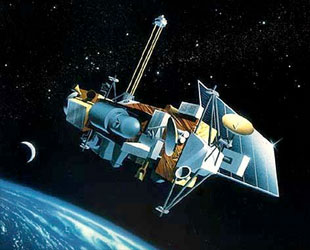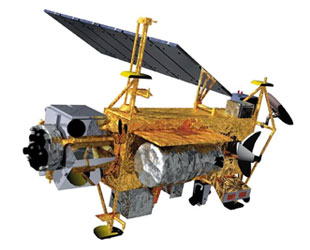September 7, 2011 — NASA's first major satellite as part of its "Mission to Planet Earth" program is now, ironically, on a much more literal mission back to the planet.
The 6.5-ton Upper Atmosphere Research Satellite (UARS) will return to Earth in the next several weeks, according to NASA. At least some pieces of the spacecraft, which is 35 feet long and 15 feet wide, are expected to survive the fiery plunge into the atmosphere and reach the ground.
"It is too early to say exactly when UARS will re-enter and what geographic area may be affected," NASA said in a statement posted on Wednesday (Sept. 7) to its website.
Deployed in September 1991 by space shuttle Discovery's STS-48 crew, UARS was designed to help scientists learn more about the mixture of gases protecting Earth from the harsh environment of space.

Artist's concept showing UARS in orbit around the Earth. (NASA) |
By recording data about the chemical compounds found in the ozone layer, wind and temperature in the stratosphere, as well as energy input from the sun, UARS helped define the role that Earth's upper atmosphere has in climate and climate variability.
Originally planned to operate for just three years, UARS mission continued for more than an additional ten. When the school bus-size spacecraft's last battery shorted out in December 2005, six of its ten science instruments were still functioning.
NASA commanded UARS to a lower orbit before shutting the satellite down. It was then just a matter of waiting for the spacecraft's orbit to decay.
Two years later however, UARS made headlines again as a result of it being struck by an unknown object — either a piece of space debris or a meteoroid — breaking off four large pieces.
Large landing zone
As of Wednesday (Sept. 7), UARS was orbiting 155 miles by 174 miles (250 km by 280 km) above the Earth.
Because the satellite is inclined 57 degrees to the Earth's equator, any surviving debris from UARS will land within a zone between 57 degrees north latitude and 57 degrees south latitude.
That means pieces could fall over most of the world's six inhabited continents as well as its three largest oceans.
"It is impossible to pinpoint just where in that zone the debris will land, but NASA estimates the debris footprint will be about 500 miles long," the space agency said.

NASA's Upper Atmosphere Research Satellite (UARS). (NASA) |
The risk to public safety or property is extremely small. Since the beginning of the Space Age in the late-1950s, there have been no confirmed reports of an injury resulting from re-entering space objects. Nor is there a record of significant property damage resulting from a satellite re-entry.
Just the same, NASA is advising the public should debris fall around them.
"If you find something you think may be a piece of UARS, do not touch it. Contact a local law enforcement official for assistance," the space agency said.
Tracking UARS
NASA will be posting weekly updates to its website until four days before the anticipated re-entry. It then plans to update daily until about 24 hours before re-entry, when the updates will be made more frequently.
"The actual date of re-entry is difficult to predict because it depends on solar flux and the spacecraft's orientation as its orbit decays. As re-entry draws closer, predictions on the date will become more reliable," NASA said.
UARS's path back to Earth is being tracked by the Joint Space Operations Center of U.S. Strategic Command at Vandenberg Air Force Base, Calif., which works to detect, identify and track all man-made objects circling the Earth, including space junk.
